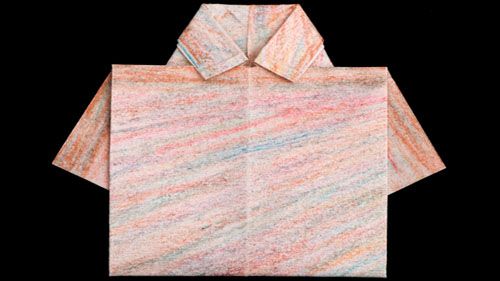
Losing Your Shirt
Objectives
- Become aware of the interdependence between countries, imbalances in the distribution of wealth, and inequalities around the world today;
- Realize that part of the economic and environmental problems in developing countries is attributable to actions by industrialized countries;
- Discover various advertising strategies;
- Learn about different ways to become a responsible consumer.
Description
Students are broken down into teams that represent small businesses and are asked to make origami shirts in exchange for wages that must remain a secret until a bit later. Once the wages are paid, each team will draw up a budget using a grocery store flyer in order to prepare one day’s worth of meals. Some will get enough to eat, others will not. After playing out this scenario, students draw parallels with the situation of workers in developing countries.
Equipment
- An Origami Shirt document;
- Cheques for Distribution document;
- One grocery store flyer per team of two students;
- Letter-size paper.
Introduction
Tell students you received a request from the school principal to make origami shirts. They will be used to raise community awareness about the working conditions of textile workers.
Ask students whether they are willing to spend 30 minutes of their class time to make these.
Separate the class into teams of two students and explain that each team represents a different manufacturer. Ask the students to make paper shirts using the instructions in the document titled An Origami Shirt. Remind them that they have 30 minutes to make the shirts and that the teams who make the most will be rewarded.
Make the rounds of the desks, encouraging students to make as many shirts as possible. Behave like a factory foreman.
End the activity after 30 minutes.
Instructions
Randomly distribute a cheque to each student for the work performed by every team. See the document titled Cheques for Distribution.
Warn the students that their wages must remain secret and should not be shared with other teams under any circumstance.
Explain to students that the wages they received are the same as those paid for a full day’s work to textile workers in certain countries around the world.
Distribute a grocery store flyer to every team.
Ask the students to draw up a budget based on these wages in order to prepare three meals for two people for one day, using the advertising flyers given to them. Insist that students create balanced meals as much as possible. Ask students to present their budget. Help them realize that not everyone will be able to meet their needs: some will still be hungry, while others will have money left over in their pockets after eating.
Ask the students if they know why some students are able to make ends meet but others cannot.
Encourage students to discuss wages based on the task they had to carry out. Ask them questions like:
- What do you think about the fact that people doing the same work receive such different wages?
- Why is that?
- Why is it that two workers, doing exactly the same work, receive different wages?
Ask the students to find out where one of their items of clothing comes from (e.g., shirt, sweater, jacket) by checking the clothing label.
Write the country names on the board.
Ask students to prepare a table with three columns indicating three categories of manufacturing countries: manufactured here, manufactured in another industrialized country, manufactured in a developing country. Get them to write down the name of each country in the corresponding column.
Tell the students you would like to buy a shirt. Ask them whether the desired shirt, of the same quality, will be more or less expensive if it is produced here, in another industrialized country, or in a developing country. Jot down the students' answers.
Initiate a discussion with students using the following questions:
- Is it normal that a shirt from Korea is less expensive than one manufactured in Canada?
- Why?
Help students make connections regarding the product's source.
In principle, production costs should be higher, in particular due to shipping costs. Tell students that for a shirt of equal quality, the less expensive one was probably produced in conditions that are harmful to the environment and that take advantage of local populations.
Explain that some companies that boast of having the lowest prices have no regard for the working conditions of their employees. Their only goal is to make as much profit as possible. When we make decisions as consumers, it is important to find out about the ethics of companies. Otherwise, our purchase may well encourage deplorable situations.
Tell students that more and more people are aware of these inequities. In Europe, the Made in Dignity label facilitates closer bonds between consumers and manufacturers through fair trade.
Conclusion
Wrap up the activity by asking students to find solutions for responsible consumer behaviour, without encouraging inequity or injustice.
As necessary, use the following solutions and others like them to encourage discussion:
- Stop buying the item in question: a courageous solution.
- Consume less: prevents waste.
- Buy in bulk: a way around excess packaging.
- Make things yourself, like your own clothes and food, etc.: leads to considerable savings.
- Buy local products: encourages the local economy.
- Choose fair trade products: fosters worker dignity.












